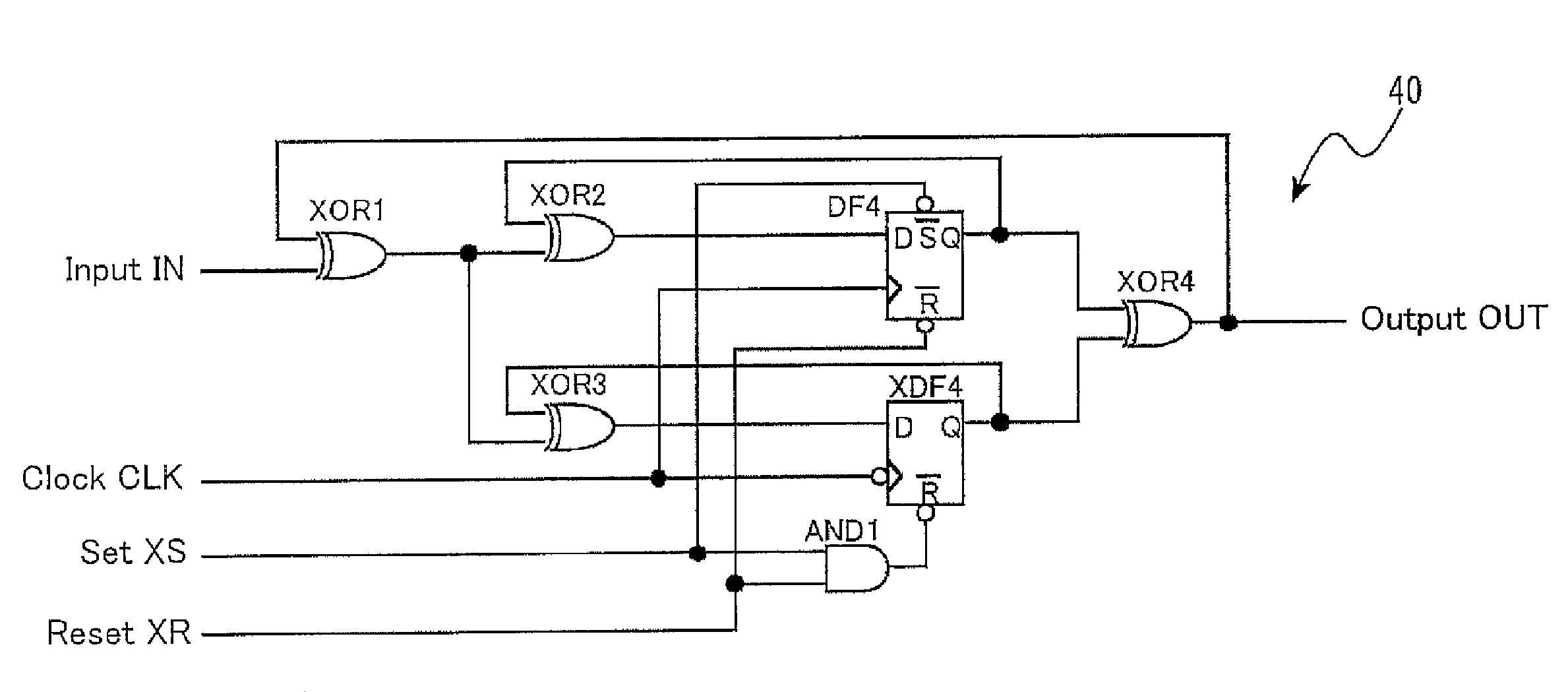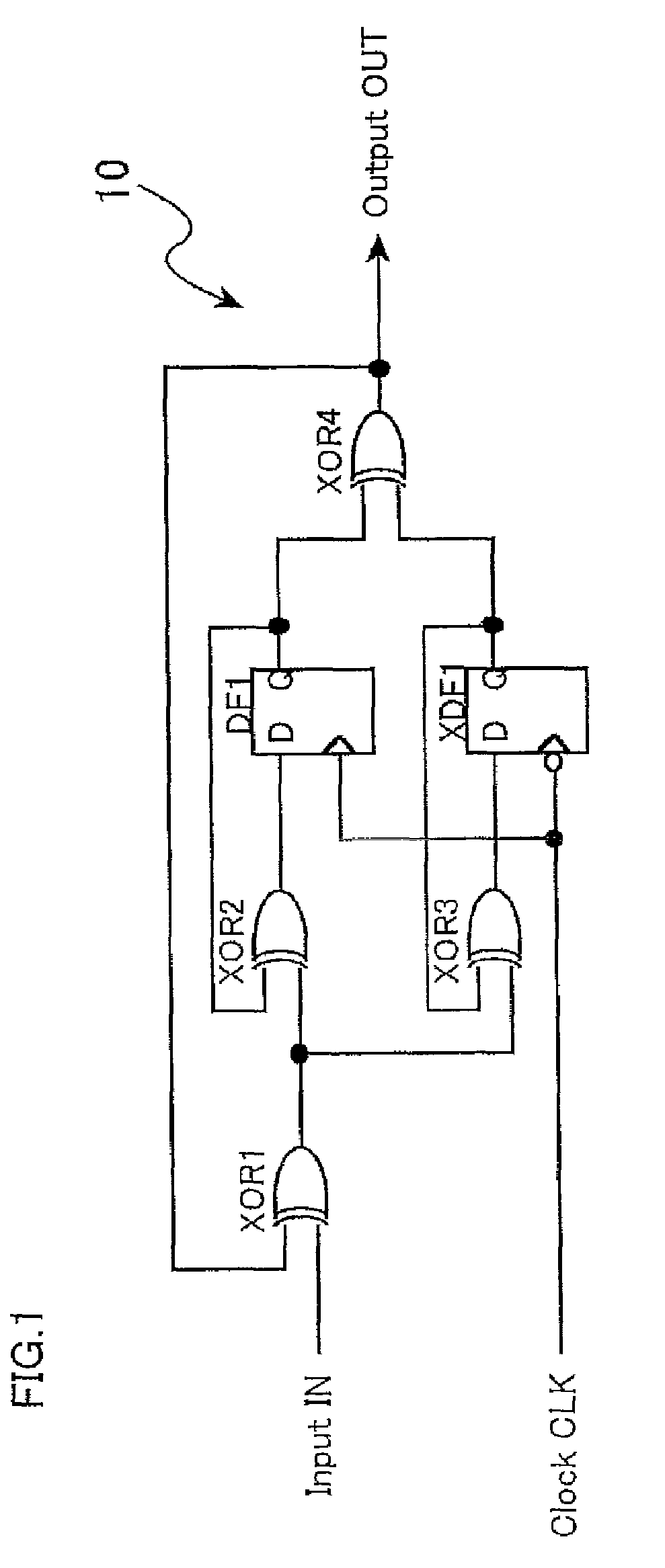Data holding circuit and signal processing circuit
a signal processing circuit and data holding technology, applied in the direction of pulse generators, pulse techniques, electrical equipment, etc., can solve the problems of generating glitch noise at signal switching timings, difficult to find out at which timing and/or in which signal glitch noise is generated, and reducing current consumption and unnecessary radiation noise, simple structure, and improved process precision
- Summary
- Abstract
- Description
- Claims
- Application Information
AI Technical Summary
Benefits of technology
Problems solved by technology
Method used
Image
Examples
embodiment 1
[0050]FIG. 1 is a circuit diagram showing an exemplary essential structure of a data holding circuit 10 according to Embodiment 1 of the present invention.
[0051]In FIG. 1, the data holding circuit 10 according to Embodiment 1 includes: two flip-flops DF1 and XDF1; and four exclusive OR circuits XOR1 to XOR4 for each outputting a signal of ‘0’ (L level) when it receives the same inputs (e.g., L and L, or the like), and outputting a signal of ‘1’ (H level) when it receives different inputs (e.g., H and L, or the like).
[0052]The exclusive OR circuits XOR1 to XOR4 each output a signal of ‘0’ (L level) when it receives the same input signals of ‘0’ or ‘1’, and outputs a signal of ‘1’ (H level) when it receives different input signals of ‘0’ and ‘1’.
[0053]Input ends of the first exclusive OR circuit XOR1 receive an input signal IN and an output signal from the fourth exclusive OR circuit XOR4, respectively. Input ends of the second exclusive OR circuit XOR2 receive an output signal from t...
embodiment 2
[0068]Embodiment 2 will describe a case in which the first flip-flop DF1 and the second flip-flop XDF1 according to Embodiment 1 are each provided with an asynchronous reset terminal R, they are denoted as a first flip-flop DF2 and a second flip-flop XDF2, respectively, and a final output signal OUT can be reset to ‘0’ by a reset signal XR.
[0069]FIG. 3 is a circuit diagram showing an exemplary essential structure of a data holding circuit 20 according to Embodiment 2 of the present invention.
[0070]In FIG. 3, the data holding circuit 20 according to Embodiment 2 includes: first and second flip-flops DF2 and XDF2; and four exclusive OR circuits XOR1 to XOR4.
[0071]An asynchronous reset terminal R is provided to each of the first flip-flop DF2 and the second flip-flop XDF2. The reset terminal R of each of the first flip-flop DF2 and the second flip-flop XDF2 receives a reset signal XR. It should be noted that the other structures in the data holding circuit 20 are similar to those for t...
embodiment 3
[0078]Embodiment 3 will describe a case in which the first flip-flop DF1 according to Embodiment 1 is provided with an asynchronous set terminal S, and the second flip-flop XDF1 according to Embodiment 1 is provided with an asynchronous reset terminal R, they are denoted as a first flip-flop DF3 and a second flip-flop XDF3, respectively, and a final output signal OUT can be set to ‘1’ by a set signal XS.
[0079]FIG. 5 is a circuit diagram showing an exemplary essential structure of a data holding circuit 30 according to Embodiment 3 of the present invention.
[0080]In FIG. 5, the data holding circuit 30 according to Embodiment 3 includes: first and second flip-flops DF3 and XDF3; and four exclusive OR circuits XOR1 to XOR4.
[0081]The first flip-flop DF3 is provided with an asynchronous set terminal S, and the second flip-flop XDF3 is provided with an asynchronous reset terminal R. A set signal XS is input to each of the set terminal S of the first flip-flop DF3 and the reset terminal R o...
PUM
 Login to View More
Login to View More Abstract
Description
Claims
Application Information
 Login to View More
Login to View More - R&D
- Intellectual Property
- Life Sciences
- Materials
- Tech Scout
- Unparalleled Data Quality
- Higher Quality Content
- 60% Fewer Hallucinations
Browse by: Latest US Patents, China's latest patents, Technical Efficacy Thesaurus, Application Domain, Technology Topic, Popular Technical Reports.
© 2025 PatSnap. All rights reserved.Legal|Privacy policy|Modern Slavery Act Transparency Statement|Sitemap|About US| Contact US: help@patsnap.com



